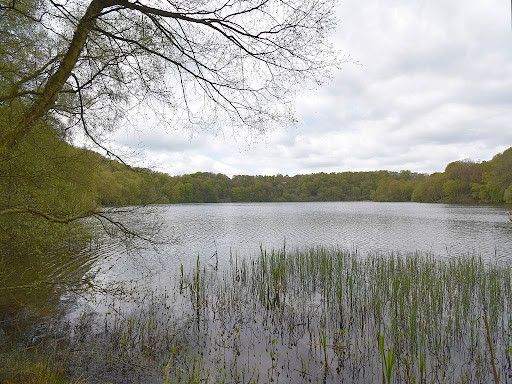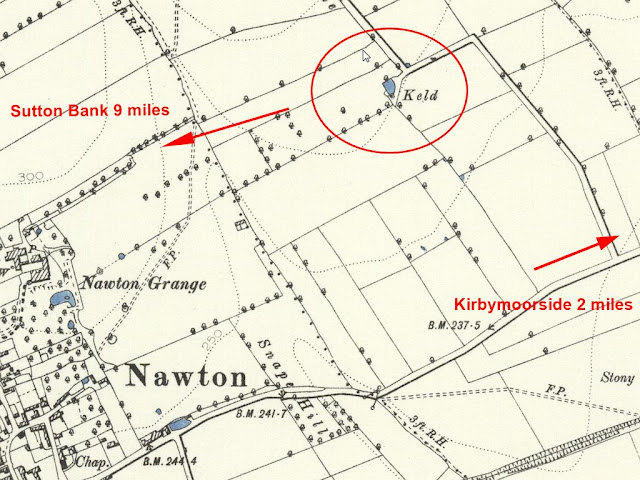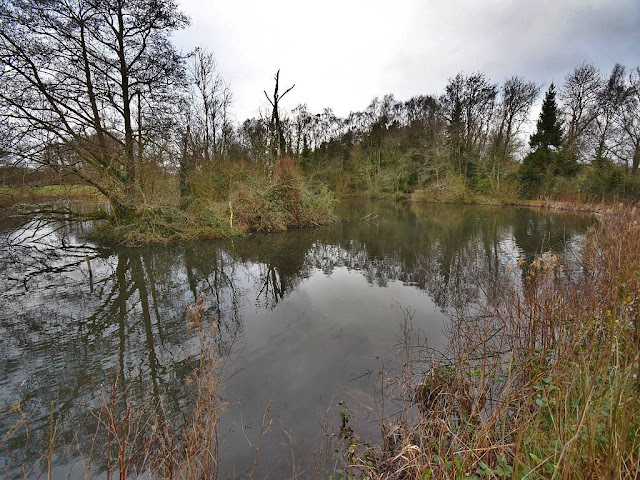
|
| Gormire lake |
A previous post looked into some of the folklore and beliefs connected with Gormire Lake located four miles to the east of Thirsk.
One legend has it that a small town once stood where the lake is now, but on one fateful night an earthquake struck the town, and it sank into the earth. A great flood of water then covered the town and created Gormire lake. The folklore also says that under certain conditions, roof tops and chimneys can be seen below the surface of the lake, along with the glint of silver plates from the houses. Else where in the country these kind of stories have been shown to contain a grain of truth, with the discovery of submerged remains of Iron Age 'Crannog' type houses that were built out over the water. The reference to glinting metal work is also interesting in connection with votive deposits that were thrown into lakes during the Iron Age, and the proximity of the massive Iron Age hill fort on the hill top above the lake.
Another version of the legend has it that a castle once stood where the lake is, and that the knight who owned the castle killed his wife in a fit of jealousy. As punishment for this crime the castle sank into the earth, and was covered by the lake. These stories are probably connected with the belief that the centre of the lake was bottomless, and also an entrance to hell.
The witches Leap
John Fairfax-Blakeborough mentions another local story about a witch
called Abigail Craister who was chased along the Hambleton hills above Gormire
lake ...
"An interesting old MS., which fell into my hands some time ago, gives an
account of her being hunted by hounds, which runs as follows : — Of this
dame it is remembered that once she being hard pressed by hounds upon her
track, did from ye cliffe fling herself bodily into Gormire Lake, and there
sinking came not forth from that place but from a keld spring or hole, over
nine good miles from ye lake." (Fairfax-Blakeborough, 1907)

|
| did from ye cliffe fling herself bodily into Gormire Lake |
Although no direction is mentioned in this story, it seems likely that this is another (possibly earlier) example of the belief in an underground stream passage from Gormire lake, heading eastward under the hill side (see previous Gormire post). If this was the case, then 'nine good miles' from the lake would be the area around Beadlam and Nawton villages to the west of Kirbymoorside. 'Keld' is an old word for a spring, and is interesting to note that the old OS maps show a spring fed pool called the "Keld" in the fields between Nawton and Kirbymoorside. This pool has been enlarged in recent years, but in its original form it would 'fit' nicely with the story of the witch bobbing to the surface after traveling along an underground stream from Gormire lake.

|
| Keld Pond - "nine good miles" from Gormire |

|
| The Keld Pond near Nawton |
Further to the south-east of Nawton village, the old maps also mark a group of 4 springs called the 'Keld Springs', but these appear to have been small stream outflows rather than pools. Although this is another possible candidate for the 'Keld' in the story, it is perhaps harder to picture the witch 'emerging' from one of these small springs (but see end notes).
Another possibility is that the 'keld spring or hole' mentioned in the manuscript was a mixed up reference to the small village of Keldholme, just to the east of Kirbymoorside, but this village is actually 13 miles from Gormire lake. However, at Keldholme there is a natural feature called the 'Spring Head', where a stream of water emerges from a cave in the bank of the river Dove. Again, this curious feature must have been the cause of much speculation in the past as to where the water came from, and again the 'Spring Head' would be a fitting location in the story for the witch to re emerge from an underground stream.

|
| Water flowing from the Spring Head cave into the river at Keldholme |
As folklore often changes over time, it is possible that all these
locations featured in the Abigail Craister story depending on where it was
being told or by whom, although the Nawton Keld pond is perhaps the best 'fit'
for the folklore.
End notes
John Fairfax-Blakeborough noted that Abigail Craister was locally
believed to be a witch, and that she had the power to transform herself into a
hare or a black dog. In the story she was chased by a pack of hounds, which
suggests that she was in the form of a hare, but this is not mentioned
specifically, and it may be that the dogs were set after the old woman. From
this it is also unclear if the shape shifting witch emerged from the Keld
Spring in her human form or as a hare.
As an example of the 'flexible' nature of folklore, it is worth pointing out that from the cliff tops above Gormire lake a person (or animal) would have to jump over 400m to land even at the waters edge. An impossible distance for an old lady witch or a hare - unless of course they used their supernatural powers!
This 'Witches Leap' story is perhaps part of a tradition along the
western edge of the moors, with the story of the Abbot of Rievaulx on his
white horse jumping into the lake, or the
Devil leaping from Roulston Scar,
or the
Hob of Over Silton
jumping from the hill top above the village.
In Scotland there is another 'Witches Leap' in the village of Carlops, 12 miles south of Edinburgh. A prominent crag in the village is known as the Carlins Loup (meaning the witches leap) from where witches would jump to a nearby hill. The Carlin name can also refer to the Cailleach - a supernatural shape shifting figure in Scottish folklore who created features in the landscape. An echo of the Cailleach can perhaps be seen in the 'Old Wife' figure to be found in North York Moors folklore.
Reference
Fairfax-Blakeborough, J. (1907) England's Oldest Hunt

Post a Comment